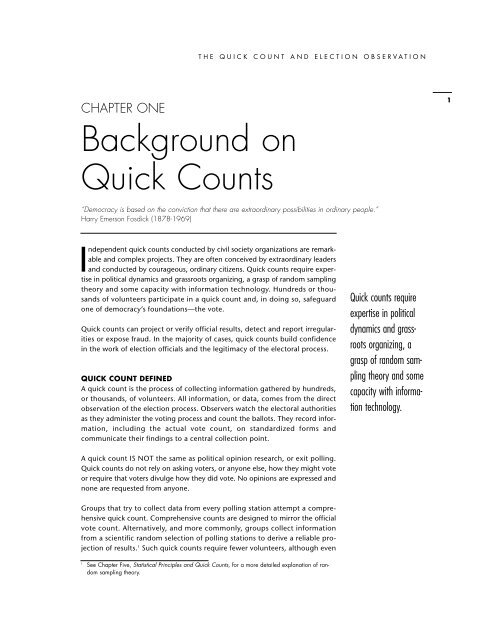The Quick Count and Election Observation
The Quick Count and Election Observation
The Quick Count and Election Observation
Create successful ePaper yourself
Turn your PDF publications into a flip-book with our unique Google optimized e-Paper software.
THE QUICK COUNT AND ELECTION OBSERVATION<br />
CHAPTER ONE<br />
1<br />
Background on<br />
<strong>Quick</strong> <strong>Count</strong>s<br />
“Democracy is based on the conviction that there are extraordinary possibilities in ordinary people.”<br />
Harry Emerson Fosdick (1878-1969)<br />
Independent quick counts conducted by civil society organizations are remarkable<br />
<strong>and</strong> complex projects. <strong>The</strong>y are often conceived by extraordinary leaders<br />
<strong>and</strong> conducted by courageous, ordinary citizens. <strong>Quick</strong> counts require expertise<br />
in political dynamics <strong>and</strong> grassroots organizing, a grasp of r<strong>and</strong>om sampling<br />
theory <strong>and</strong> some capacity with information technology. Hundreds or thous<strong>and</strong>s<br />
of volunteers participate in a quick count <strong>and</strong>, in doing so, safeguard<br />
one of democracy’s foundations—the vote.<br />
<strong>Quick</strong> counts can project or verify official results, detect <strong>and</strong> report irregularities<br />
or expose fraud. In the majority of cases, quick counts build confidence<br />
in the work of election officials <strong>and</strong> the legitimacy of the electoral process.<br />
QUICK COUNT DEFINED<br />
A quick count is the process of collecting information gathered by hundreds,<br />
or thous<strong>and</strong>s, of volunteers. All information, or data, comes from the direct<br />
observation of the election process. Observers watch the electoral authorities<br />
as they administer the voting process <strong>and</strong> count the ballots. <strong>The</strong>y record information,<br />
including the actual vote count, on st<strong>and</strong>ardized forms <strong>and</strong><br />
communicate their findings to a central collection point.<br />
<strong>Quick</strong> counts require<br />
expertise in political<br />
dynamics <strong>and</strong> grassroots<br />
organizing, a<br />
grasp of r<strong>and</strong>om sampling<br />
theory <strong>and</strong> some<br />
capacity with information<br />
technology.<br />
A quick count IS NOT the same as political opinion research, or exit polling.<br />
<strong>Quick</strong> counts do not rely on asking voters, or anyone else, how they might vote<br />
or require that voters divulge how they did vote. No opinions are expressed <strong>and</strong><br />
none are requested from anyone.<br />
Groups that try to collect data from every polling station attempt a comprehensive<br />
quick count. Comprehensive counts are designed to mirror the official<br />
vote count. Alternatively, <strong>and</strong> more commonly, groups collect information<br />
from a scientific r<strong>and</strong>om selection of polling stations to derive a reliable projection<br />
of results. 1 Such quick counts require fewer volunteers, although even<br />
1<br />
See Chapter Five, Statistical Principles <strong>and</strong> <strong>Quick</strong> <strong>Count</strong>s, for a more detailed explanation of r<strong>and</strong>om<br />
sampling theory.


